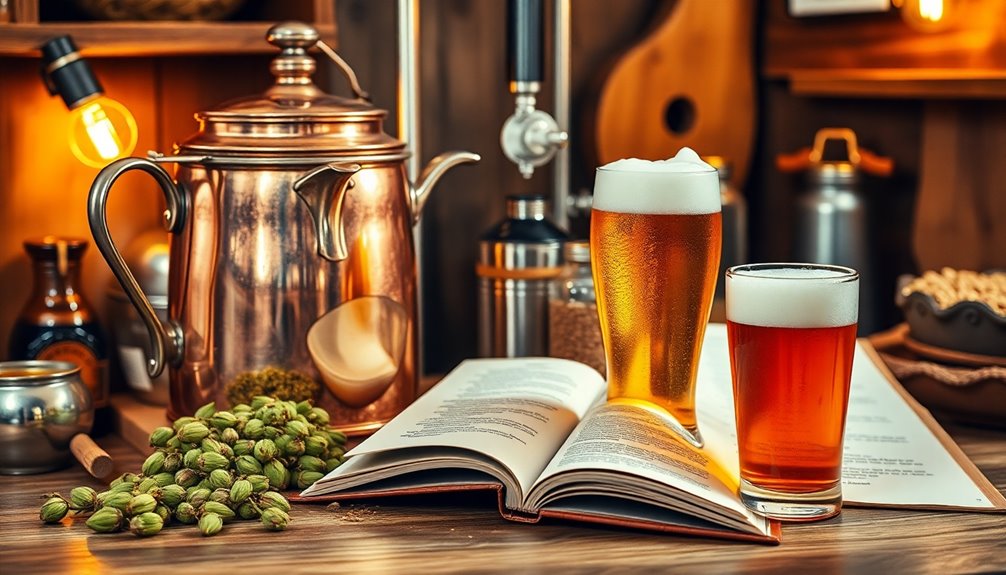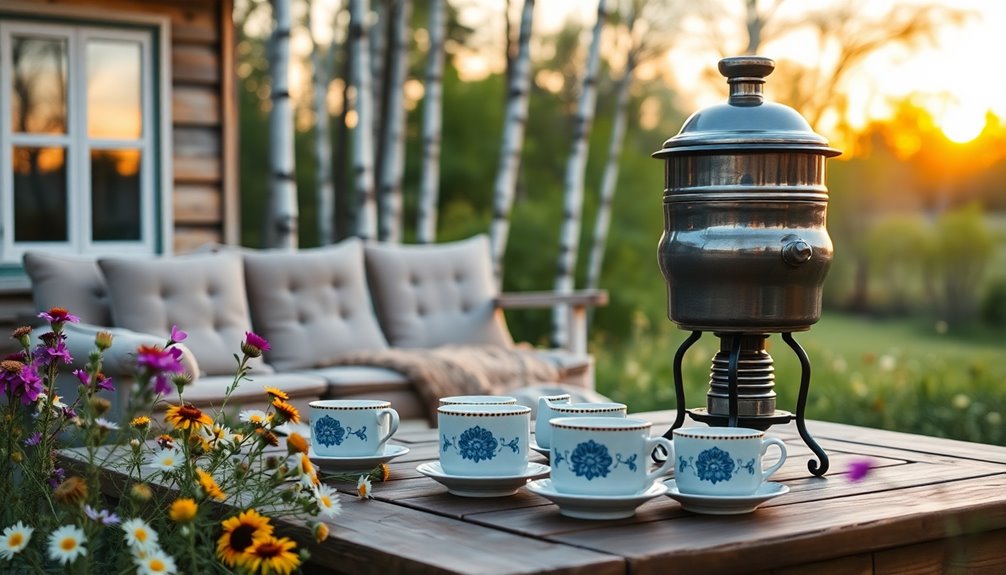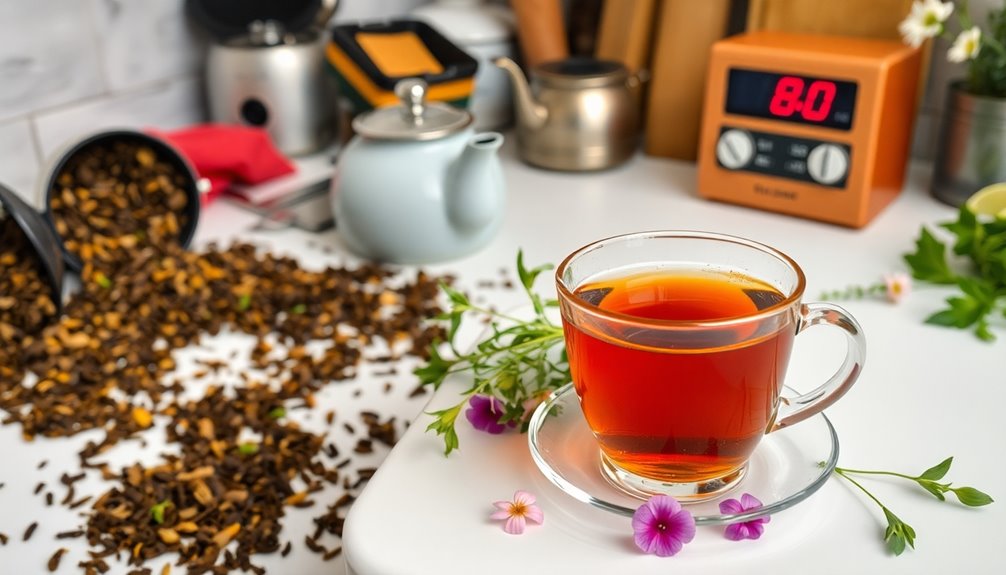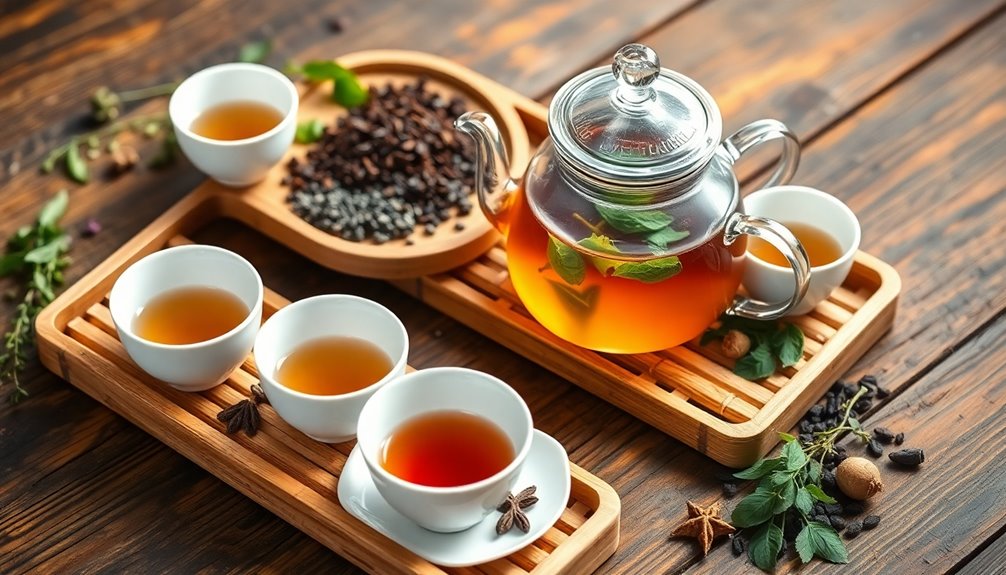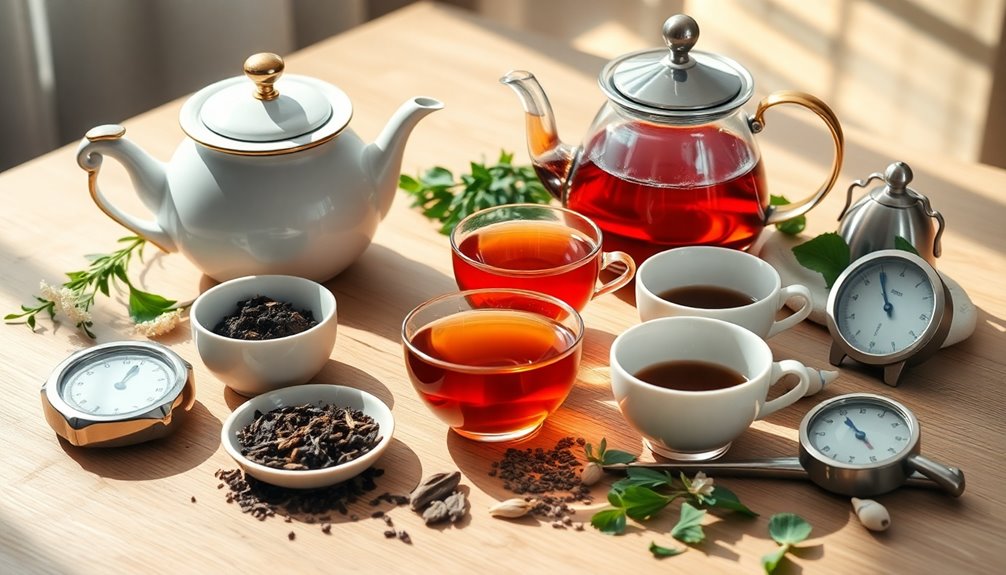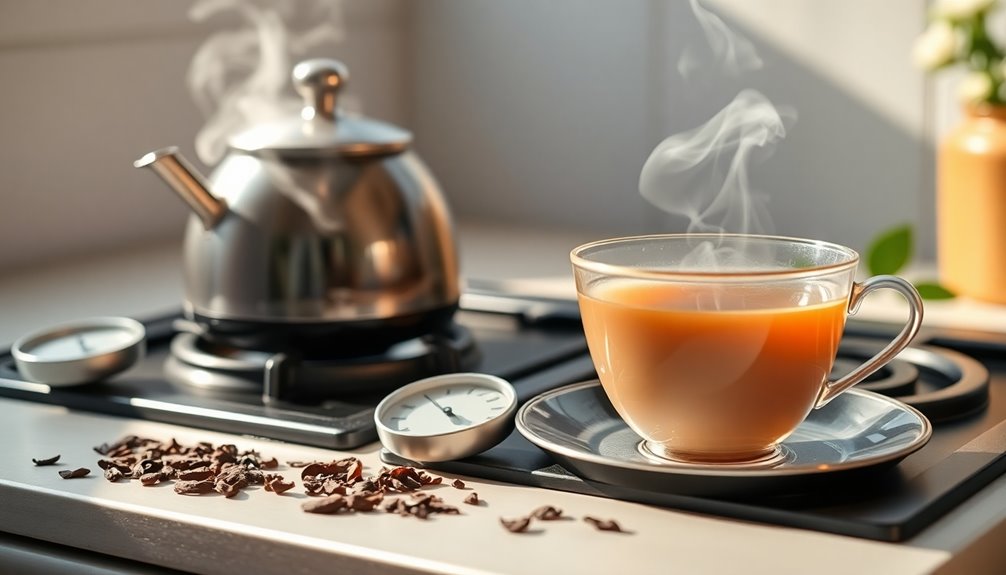To master the art of brewing coffee, start with fresh, roasted beans, 'cause they make a big difference in flavor! Experiment with grind size, water temperature, and the coffee-to-water ratio to discover your perfect cup. Did you know that different beans have unique tastes? Ethiopian coffee can taste fruity, while Asian varieties might feel earthy! Also, check out various brewing methods like French press and pour-over to find what you love best. Embracing these tips will help you brew with confidence, and who knows what delicious surprises await? If you keep going, you'll uncover even more brewing secrets!
Key Takeaways
- Use freshly roasted beans within weeks of the roast date to ensure optimal flavor in your brew.
- Experiment with grind size and coffee-to-water ratio to find the perfect balance for your preferred brewing method.
- Monitor water temperature closely, aiming for 195-205°F for optimal extraction and flavor enhancement.
- Explore various brewing methods like pour-over or French press to discover unique flavor profiles and experiences.
- Practice regularly and embrace experimentation to refine your brewing skills and develop your personal coffee preferences.
Introduction
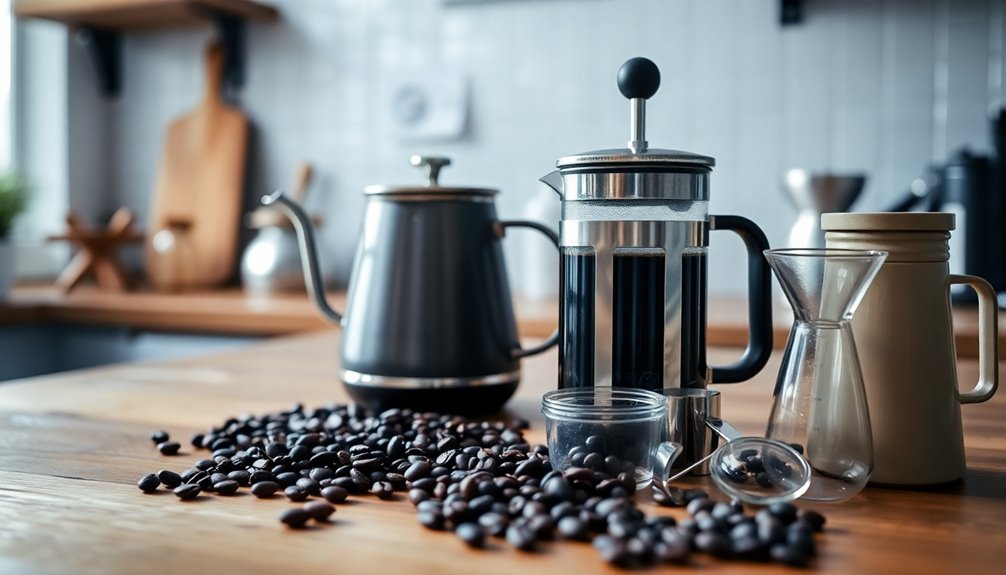
Brewing your own coffee at home opens up a world of flavor and personalization that you just can't get from store-bought options. Imagine choosing the freshest, most delicious beans, grinding them just right, and using the perfect water temperature—all to create a cup of coffee that's truly yours!
The key to a great brew is understanding your ingredients. Freshly roasted beans are a must; they should be used within weeks of their roast date to keep that fantastic flavor and aroma.
When it comes to grinding, the size matters! A fine grind works well for espresso, while a coarser grind suits methods like French press. Brewing with coarsely ground coffee ensures optimal extraction for a rich flavor profile.
Experimenting with different brewing techniques—like drip, Aeropress, or cold brew—lets you discover new tastes you never knew you'd love. Always pay attention to your water-to-coffee ratio; it's like a little recipe for success!
Don't be afraid to try new things. The more you practice and experiment, the better your coffee will be. With each cup, you'll deepen your appreciation for the art and science of brewing.
Brewing Methods Evolution Over Time
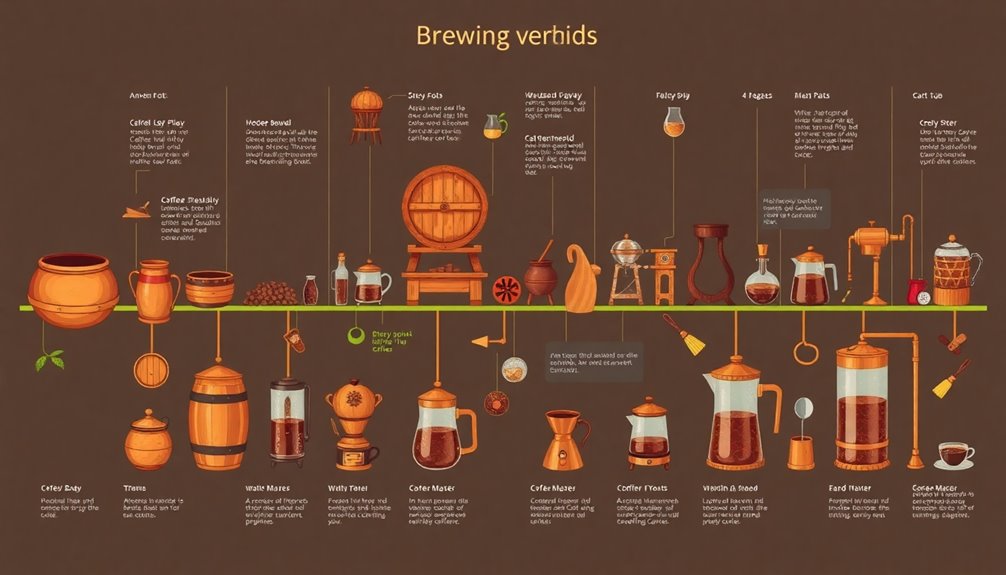
Over the years, coffee brewing methods have evolved significantly, reflecting both cultural trends and advancements in technology. You might think of the percolator, which was popular in the early 19th century; it brewed strong coffee but often over-extracted, leading to bitter flavors.
Then, in 1908, Melitta Bentz introduced the paper filter, and suddenly, drip brewing became the go-to method for cleaner, tastier coffee.
Fast forward to 1929, and the French press emerged, allowing you to steep coffee grounds in hot water, creating a rich, full-bodied flavor.
By the 1970s, the pour-over method gained popularity, especially with the Chemex, focusing on the perfect brewing time and water temperature for optimal extraction.
Today, modern innovations like the AeroPress and siphon coffee makers let you experiment with different brewing methods, catering to your taste preferences.
You can play with the coffee-to-water ratio and adjust the water temperature to match your personal preferences.
The Art of Coffee Brewing has never been more exciting, so grab your favorite beans and start brewing!
Coffee's Flavor Varies by Origin
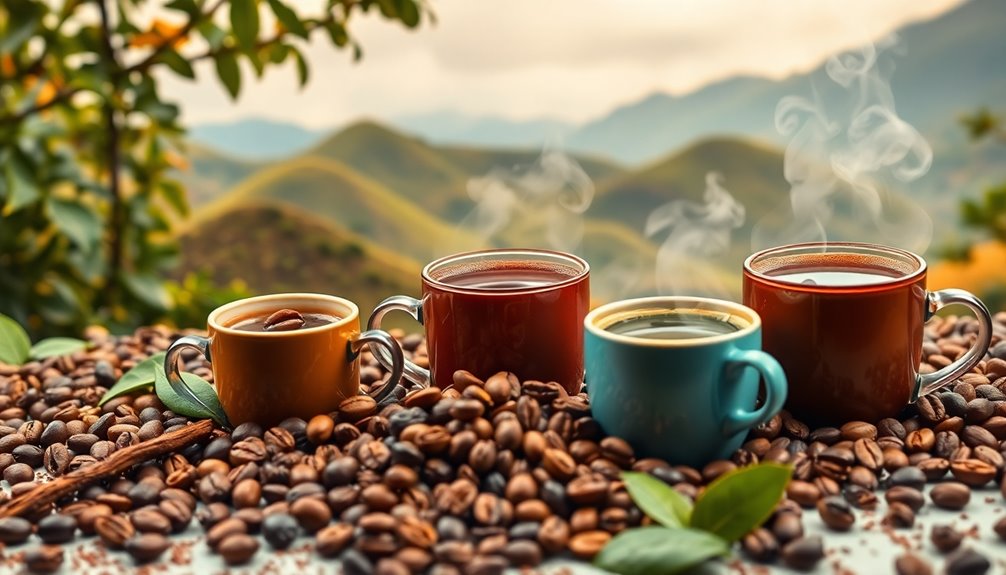
Coffee's flavor can transport you to different corners of the globe, with each origin offering a unique tasting experience. When you brew coffee, the beans you choose really matter!
For instance, South American coffee beans from Colombia and Brazil often have a balanced flavor profile, featuring delicious notes of chocolate and nuts. This makes them perfect for various brewing methods.
On the other hand, African coffee beans, especially from Ethiopia and Kenya, bring fruity characteristics like berries and citrus, giving you a bright and zesty cup.
If you prefer something earthier, Asian coffee varieties from Sumatra and Vietnam offer rich, herbal flavors with a full body.
The way coffee beans are processed also impacts their flavor. Natural processed beans, for example, tend to be fruitier since the pulp stays on during drying.
Remember, the grind size and coffee-to-water ratio are key to mastering the art of brewing! Adjust these to match the flavor profile you're aiming for.
Cultural Significance of Coffee Brewing
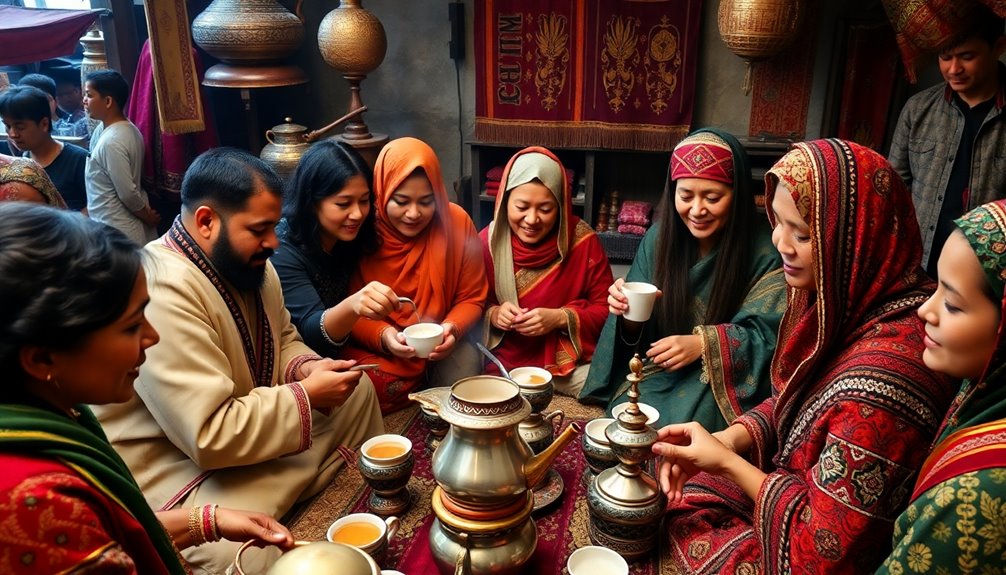
Exploring the flavors of coffee from various origins not only enhances your brewing experience but also connects you to rich cultural traditions.
Coffee brewing is more than just making a drink; it's about celebrating cultural heritage! In Ethiopia, legends tell of how coffee was discovered in the 9th century, tying it to local social gatherings.
In Turkey, coffee is so important that UNESCO recognized its brewing methods as part of humanity's cultural heritage, showcasing hospitality and community.
When you think about precision in brewing, consider Japan's "Kōbido," where the art of coffee making is a mindful practice. It's all about taking your time.
And let's not forget Italy! Espresso culture there encourages social interaction, with cafes serving as lively spots for friends to gather, sip coffee, and chat.
With the rise of specialty coffee movements, there's a renewed love for different brewing methods. You can explore the unique traditions behind coffee origins from around the world.
Sustainability in Coffee Production

Embracing sustainable coffee production practices is essential for protecting our planet and ensuring a fair future for farmers.
By choosing shade-grown coffee, you're helping to preserve biodiversity, which means more plants and animals can thrive! This method reduces the need for chemical fertilizers and pesticides, making coffee better for the environment.
When you buy from certified farms, you support efforts that improve soil health and water conservation.
These farms can see a boost in biodiversity by up to 30%! And let's not forget about Fair Trade certification, ensuring farmers receive a fair price, which helps their communities grow stronger.
Investing in sustainable coffee varieties boosts yields and gives farmers a better chance against climate change.
Plus, using water-saving techniques can cut water usage by up to 80%, greatly lowering the environmental impact of coffee production. Additionally, the direct trade relationships fostered by companies can enhance the quality and sustainability of the coffee supply chain.
Practical Applications

When you want to brew the perfect cup of coffee, applying practical techniques can make all the difference. Start by choosing the right grind size for your brewing method. If you're brewing espresso, go for finer grinds, while coarser ones work best for a French press or cold brew.
Next, keep an eye on your water temperature; aiming for 195°F to 205°F prevents your coffee grounds from getting scorched, ensuring you extract those delicious flavors. For instance, using the ideal steeping time for tea can also enhance the overall brewing experience.
Don't forget the golden coffee-to-water ratio of 1:16! This means for every gram of coffee, you'll use 16 grams of water. A kitchen scale helps you nail this every time.
When it comes to brewing time, remember that shorter times create a bright, zingy taste, while longer times give you a richer, fuller flavor.
If you're using pour-over techniques, practice a slow and steady pour to soak those coffee grounds evenly. Additionally, understanding the mechanics of French press can enhance your overall brewing experience.
Frequently Asked Questions
What Are the Four Fundamentals of Brewing?
The four fundamentals of brewing are grind size, water temperature, brewing ratio, and brewing time. Each element affects your coffee's flavor, so you'll want to experiment with them to find what you enjoy most.
What Is the Best Brewing Method?
The best brewing method depends on your taste. If you enjoy convenience, try drip brewing. For rich flavors, the French press works well. Experiment with pour-over or Aeropress for control, or enjoy refreshing cold brew on hot days.
Which Brewing Method Takes the Longest?
If you're looking for the longest brewing method, cold brew's your best bet. It takes 12 to 24 hours of steeping coarsely ground coffee in cold water, yielding a smooth, rich flavor you'll love.
Conclusion
Now that you've learned about the amazing world of brewing, you're ready to dive in and try it yourself! Remember, every cup of coffee has a story, from where the beans come from to how you make it. So, grab your favorite mug, experiment with different flavors, and share your delicious creations with friends and family. With these expert tips, you'll be brewing like a pro in no time—cheers to your coffee adventure! ☕️

